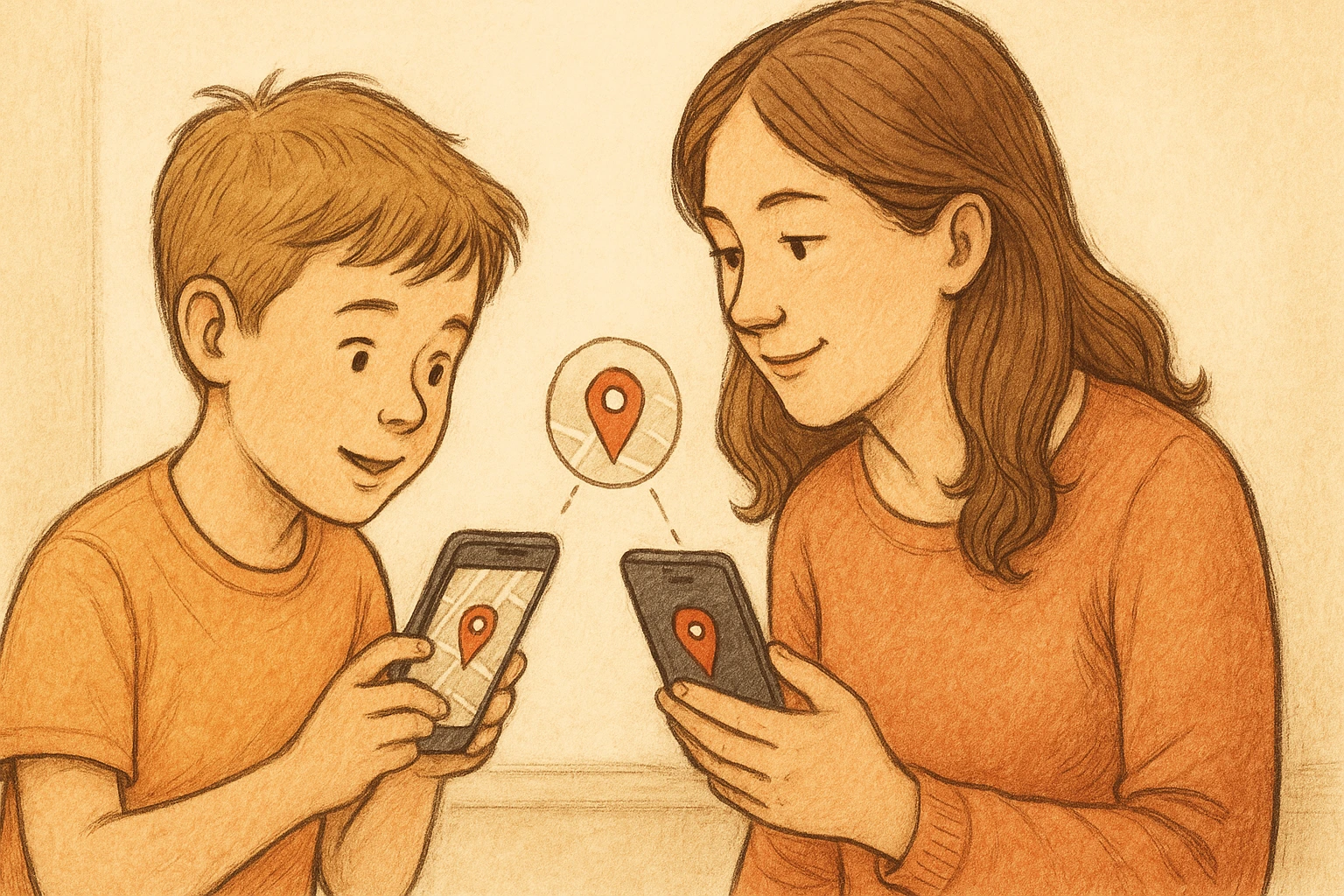In a world where people often live miles—or even continents—apart, caring for your loved ones has taken on a new form. The age of digital innovation has brought us tools that make it possible to stay connected, support well-being, and offer peace of mind, regardless of distance. Whether you’re a parent keeping tabs on your child’s safety, a caregiver looking after elderly family members, or simply someone wondering how do you know if someone’s phone is dead while trying to find a device, technology has become an indispensable ally.

Why Use Technology to Care for Loved Ones?
There’s a misconception that technology leads to disconnection, but when used mindfully, it does quite the opposite. Here are the core reasons to integrate tech into your caring routine:
🛰️ Bridging Distances in Real Time
No matter how far away your loved ones are, modern tools erase geographical limitations. From rural areas to bustling cities, a simple tap on a screen can let you see, hear, or even locate someone important to you. This level of connection was unimaginable just a couple of decades ago.
🔒 Safety First, Always
Whether it’s knowing your child got to school safely or ensuring an elderly parent is okay at home, technology helps create a security net. Devices and apps now provide alerts, status updates, and emergency notifications without being invasive.
👵 Made for Everyone—Even the Tech-Shy
You don’t have to be tech-savvy to use these tools. Many apps and devices today are designed with accessibility in mind, offering voice commands, intuitive icons, and step-by-step onboarding. That means even seniors or individuals unfamiliar with smartphones can benefit.
The Emotional Value of Digital Caring
Staying in touch with someone doesn’t just offer practical benefits—it nurtures emotional well-being. Consistent communication, visual check-ins, and timely support can ease anxiety and foster a deeper bond. Here’s what that looks like in everyday life:
- A teenager feeling comforted knowing their parent is just a text away during a school trip.
- A grandparent smiling at a shared photo album updated daily by their children.
- A partner receiving an automated “take your medication” reminder while abroad.
Incorporating small acts of care through technology leads to a big emotional payoff. These moments tell your loved ones: “I’m here. I care. You matter.”
Now that we’ve established why using technology to care for your loved ones is both meaningful and effective, it’s time to explore the practical tools that make it possible. From tracking safety to sharing memories, modern apps and gadgets can simplify your life and enhance emotional bonds in surprisingly easy ways.
Table: Common Tech-Based Caring Tools and Their Primary Benefits
| Tool | Purpose | Who It Helps Most |
| Location Tracking Apps | Real-time safety monitoring | Parents, caregivers, travelers |
| Smart Home Devices | Home security and automation | Elderly individuals, solo dwellers |
| Video Call & Messaging Apps | Constant communication and bonding | Families, long-distance couples |
| Wearable Health Devices | Health tracking and fall detection | Seniors, patients, fitness users |
| Shared Calendars & Reminders | Organizational aid and support | Families, elderly, busy parents |
1. 🗺️ Use Location Tracking Apps for Peace of Mind
One of the most powerful ways to care for your loved ones—especially children, elderly parents, or long-distance partners—is through location tracking. These apps offer real-time information and historical movement logs, so you know your loved one is safe and on track.
The Number Tracker app is a leading option for this purpose. With it, you can:
- Track a phone by its number, instantly knowing where someone is.
- Access location history, making it easier to understand daily routines or unexpected deviations.
- Receive real-time updates, ideal during commutes, trips, or unusual situations.
What sets Number Tracker apart is its user-friendly design and privacy-focused functionality. Users can control their visibility settings and grant permission only when needed. This respectful balance between safety and autonomy makes it ideal for both tech-savvy and tech-resistant individuals.
💡 Pro Tip: Discuss the use of such apps openly with your loved ones. Mutual consent turns tech tools into supportive bridges rather than sources of discomfort.

2. 🏡 Set Up Smart Home Devices
Smart home technology isn’t just for convenience—it’s a silent guardian for those who live alone or have mobility issues. Installing a few key devices can radically enhance daily security and comfort.
Here are some excellent starting points:
| Smart Device | Function | Use Case |
| Video Doorbells | See and speak to visitors via smartphone | Elderly parents checking the door without getting up |
| Smart Plugs/Lights | Control appliances and lighting remotely | Turn on lights for safety before someone arrives home |
| Emergency Alerts | Detect falls or emergencies and notify contacts | Elderly or disabled individuals living independently |
These devices are typically controlled via smartphone apps and can be installed in under an hour, often without the need for professional help.
3. 📞 Stay Connected with Video Calls and Messaging
Simple communication is the most underrated form of care. Just hearing your voice or seeing your face can brighten someone’s entire day. With digital tools, staying in touch has never been easier—or more versatile.
Consider these practices:
- Schedule regular video calls through Zoom, FaceTime, or WhatsApp.
- Create family group chats for real-time sharing of photos, jokes, or important news.
- Use voice notes or short videos to maintain a warm connection without needing to coordinate time zones.
👨👩👧👦 Family Tip: Encourage older family members to get familiar with just one messaging platform, and offer gentle tutorials to help them ease into daily digital communication.
4. ⌚ Monitor Health with Wearables
Smartwatches and fitness trackers have evolved far beyond counting steps—they are now health companions capable of saving lives. For aging parents or health-conscious loved ones, wearables offer continuous insight and protection.
Key features include:
- Heart rate and sleep monitoring, useful for tracking long-term well-being.
- Fall detection sensors, which send immediate alerts if the wearer experiences a sudden drop.
- Health data sharing, which—when permitted—keeps caregivers or relatives in the loop about potential health risks.
Devices like the Apple Watch or Fitbit offer both style and substance, with sleek designs and intuitive interfaces that even non-techies can learn quickly.
5. 🗓️ Use Reminders and Shared Calendars
Life gets busy, and remembering every important date, appointment, or task can be overwhelming—especially for older adults. Setting up shared organizational tools can provide gentle support without being overbearing.
Try these:
- Google Calendar or Apple Calendar, where family members can sync events and get reminders.
- Medication reminder apps like Medisafe, which send alerts when it’s time for a pill or refill.
- Task-sharing apps like Todoist or Microsoft To Do, perfect for couples or families coordinating responsibilities.
This tech-based nudge system empowers your loved ones to manage their own lives while offering you reassurance that nothing falls through the cracks.
Introducing new technologies into your family’s daily life can be transformative—but it also requires intention. Not every app or device fits every lifestyle. The key is to select tools that offer real value while respecting privacy, preferences, and comfort levels.
🧭 How to Choose the Right Tools
Before downloading an app or installing a smart device, ask yourself: Will this actually help? Here are some guiding principles to make the best choice.
1. ✅ Prioritize Privacy and Consent
Even the most well-meaning tech can become invasive if not handled thoughtfully. Always:
- Ask before tracking someone’s location or installing a camera in their space.
- Explain how the tool works and why you think it could help.
- Offer an opt-out option—particularly important for elderly relatives or teenagers.
A caring conversation builds trust. Remember, empowerment is more effective than control.
2. 🤝 Look for User-Friendly Solutions
Choose tools that are intuitive and require minimal setup. For tech-resistant family members, opt for:
- Large icons and simple interfaces.
- Voice-command compatibility (great for smart home setups).
- Step-by-step onboarding tutorials or customer support hotlines.
If your loved one can’t figure it out alone, the tool won’t be used—and that defeats its purpose.
3. 🔧 Check Reliability and Reviews
Not all technology is created equal. Before committing to a solution:
- Read real user reviews to understand reliability and usability.
- Test the tool yourself before recommending it to someone else.
- Look for certifications or endorsements from credible sources (e.g., privacy compliance or medical device approval).
🛠️ Tip: Stick to reputable platforms like Apple App Store and Google Play, and avoid apps with vague descriptions or unclear permissions.
🔄 Make Tech Caring a Daily Habit
Tech-based caring works best when it becomes a natural part of your routine. Here’s how to embed these habits without making life feel like a checklist:
- Morning Check-In: A quick “Good morning” message or wellness update via shared apps.
- Weekly Video Call: Pick one day a week for a face-to-face catch-up with distant family.
- Monthly Review: Go over smart device settings and make sure reminders or calendars are still aligned with real-life schedules.
- Emergency Plan: Use tools like Number Tracker to create a go-to strategy if someone doesn’t respond or deviates from usual routines.
These small rituals keep everyone involved, connected, and prepared—without any feeling of surveillance.
🧠 Table: Matching Tech Tools to Needs and Lifestyles
| Need | Best Tech Solution | Why It Works |
| Daily Safety for Elderly | Smart doorbells, fall detectors | Enables independence while staying alert |
| Teen Safety and Communication | Location tracking + chat apps | Ensures peace of mind without overstepping boundaries |
| Health Monitoring | Wearables (e.g., Fitbit, Apple) | Offers early warning signs and performance tracking |
| Coordinating Busy Families | Shared calendars + reminder apps | Prevents missed tasks and fosters collaboration |
| Long-Distance Emotional Connection | Video calls, photo sharing | Keeps bonds strong across cities or countries |
❤️ Final Thoughts: Technology as an Expression of Love
At its best, technology isn’t cold or mechanical—it’s deeply human. It’s the goodnight message that makes a parent smile. It’s the emergency alert that brings help on time. It’s the shared laugh in a group chat that makes distance disappear.
By integrating simple, smart tools into your relationships, you’re not just keeping people safe—you’re telling them, every day, in quiet digital ways: You matter to me.
Whether it’s using Number Tracker for peace of mind or setting up a calendar reminder so your grandmother doesn’t miss her doctor’s appointment, technology has given us the power to care more efficiently and more effectively than ever before.
And in a world that sometimes feels disconnected, that kind of intentional caring means everything.




